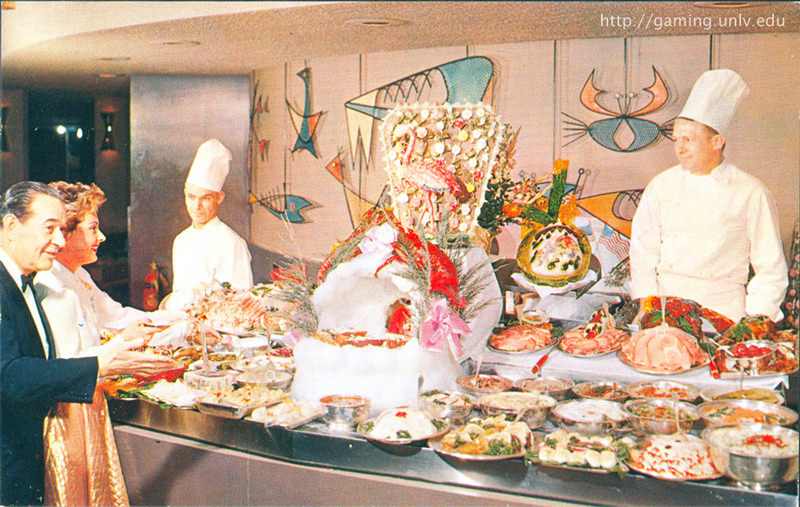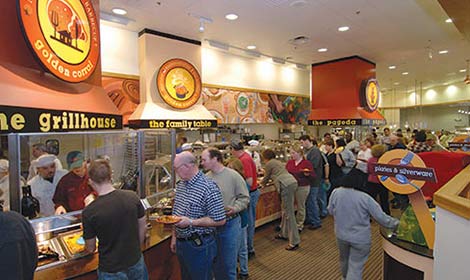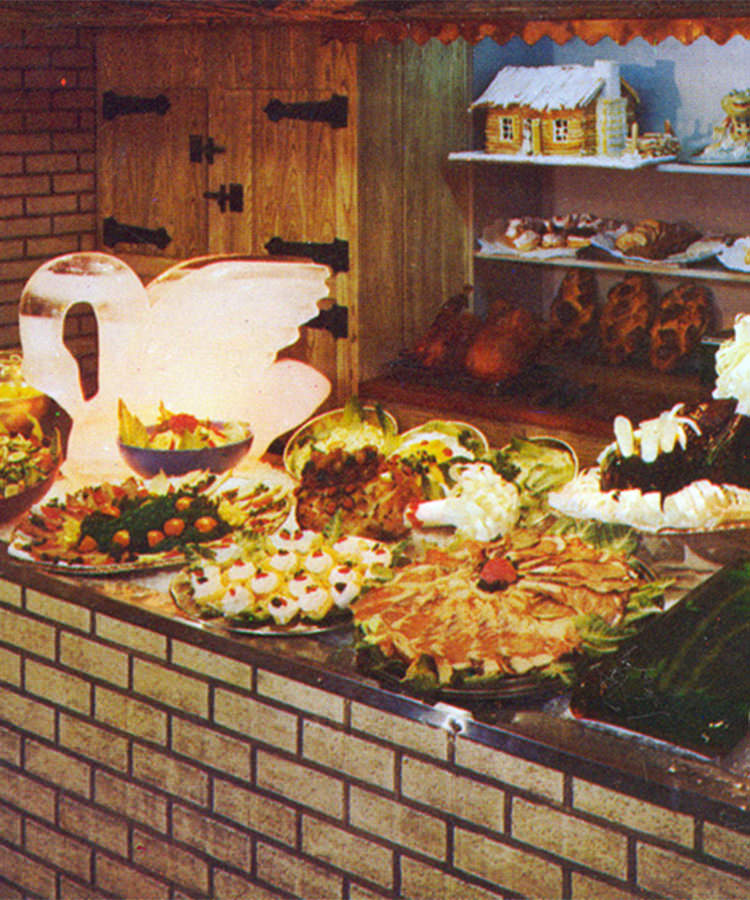
Excess and America have always played in the same sandbox. From our portion sizes to our wines to our politics, we Americans like things big. There’s no better example of our love of excess than the buffet, that cultural touchstone of culinary decadence that is so archetypally American. When all is said and done, what is more American than the almighty buffet?
Despite its ability to represent our ethos so perfectly, the word buffet originated in France. It comes from the 12th century bufet, meaning bench or stool. Since the 19th century, the word buffet in English has referred to a meal served from a sideboard.
And it’s not just its name that comes from elsewhere, either. History provides us with images of gods and nobles, royalty and the rich, even esteemed biblical figures, bathed in bread and meats, grapes and wine, gold and silver, sharing momentous occasions, sharing communal dining, and sharing rewards reaped from the wealth of abundance. These are images of the wealthy sharing, in essence, what we have come to know as the buffet.
The American iteration of this culinary institution owes some props to the Swedes, for the concept of the smörgåsbord or “smorgasbord” – a side table where one could opt for a pre-dinner drink or snack – that came to the States in 1939 during New York’s World Fair. The smorgasbord, which literally means “butter-goose table,” was an excuse to ease into the main meal by standing among family, friends, or peers, celebrating the initiation of dinner.
The American buffet grew its wings – literally – in Las Vegas, circa the 1940s. Herb McDonald created the Buckaroo Buffet, where people could choose from a selection of salads (low food cost), seafood (high food cost), and cold cuts (relatively low food cost). The goal was classic Vegas: keep people inside the casino longer, where, tempted by the tables and slot machines, they’d spend more money. McDonald’s gambit was that people would get a Viking’s feast for an arguably user-friendly price where they would gorge themselves, exhale, wash their hands (hopefully), then careen toward that blackjack table.

From its Vegas iteration, the American buffet expanded throughout the 50 states, finally achieving the height of its popularity during the 1980s, when excess was as rampant as music videos on MTV. Every other restaurant seemed to serve their own version of the buffet, featuring salads, fruits, hot food, and, Jello-O — often in more than one color.
The guests at these ubiquitous buffets tended to be larger families, traveling businessmen, and people on cruise ships or all-inclusive retreats. Television commercials influenced the 1980s buffet surge, too. Seduced by commercials and tales of excess from friends and neighbors, Americans flocked to restaurants and their buffets. Once there, they were given a choice between the buffet or a dish off the menu. But it began to feel like you were missing out if you didn’t choose the buffet. Ordering off the menu only got you one dish, after all, with a limited amount, too, so even if you loved it, you only got what the restaurant deemed to be one portion. The buffet, by comparison, was an unlimited amount of a large variety of dishes.
It was the perfect American combination of value and excess. And it proliferated accordingly into a veritable American institution. In the 1980s, Sizzler, Ponderosa, Pizza Hut, and many hotel restaurants became almost synonymous with buffets.
There’s something magical about walking up to a row of brightly lit fresh fruits and vegetables with the option to pick and choose a few sliced strawberries, four chunks of pineapple, two watermelon slices, plus red and green grapes. If it’s breakfast time, you could have bacon, sausage, pancakes with maple syrup, eggs, and hash browns. And that’s just on the first trip through the line!
The buffet is still with us, though its popularity has certainly declined. Saturation can prove unhealthy, for buffet buffs as well as for businesses. As fast as those restaurants were franchising in the 1980s, many decelerated from quick expansions and competition in the 1990s. Profiting off a buffet is as tenuous as balancing on the edge of a butter knife. There are always people looking to stash extra food in their bags and coats, people looking to cash in on street cred by boasting how much food they could consume in one sitting, and promoters swooping in and hustling the sales angles. Most buffets in Las Vegas would go out of business if they stood alone. Their sole responsibility is to keep people inside the casino.
But in addition to all this, American tastes turned a corner after the new century began. Health-conscious dining had been on the uptick for years, and the 2008 recession curbed dining out. These days, AYCE (All You Can Eat) is not something we commonly hear. But a small legacy remains. You can still find dim sum in Chinese restaurants, or you can attend a barbecue restaurant in the South for all the fixins. You can usually find an omelette station at any hotel’s weekend breakfast propped next to the eggs, bacon, sausage, pancake, waffle, and hash brown stand. Golden Corral, headquartered in North Carolina, has been specializing in the buffet since the 1970s. Entrepreneur Magazine named them the No. 1 franchisor in the United States for the 20th year. Their website boasts a signature house buffet exceeding 160 hot and cold items, a carving station for meats, a bakery station, a salad station, a dessert station, and a “smorgasboard” of homemade rolls, muffins, cookies, pies, and cakes. There are nearly 500 Golden Corral buffets in the United States, and their 2016 sales reflect a steady progression.

Larger families are still very much the target demographic of the buffet. In many American families, both parents work full-time jobs, and there is less time to prepare meals at home every night. If the restaurant is in the suburbs, there’s a good chance young families will be the target. And everything changes if the establishment is casual, fine-dining, or festooned with big-screen TVs showing eight different sporting events. If the restaurant is located just off the highway, you’ll get travelers — business commuters, truck drivers, and busloads of tourists, or athletes. More than anything, restaurant buffets fear the busload of athletes who pull up outside the establishment. While it may not be as popular as it was in the ’80s, drive through any town in America and there’s a good chance a buffet will still be waiting for you somewhere.
The scary truth of the buffet is how impossible it is to put a lid on our appetites. With all that beauty and excitement and pure possibility, and the inevitable dangerous dark side, the buffet is not just an archetype of American cuisine; it’s a metaphor for America, in all its splendid, dangerous excess.
